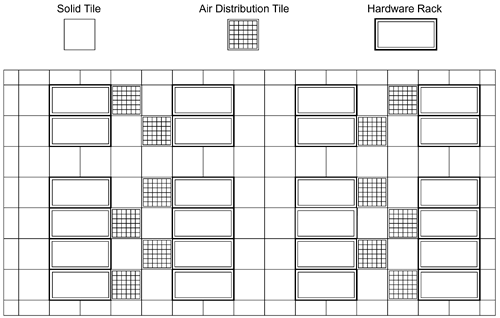Data Center Structural Layout
| The data center must be designed to accommodate diverse hardware designs and requirements, and possibly equipment from different manufacturers. Determining RLUs is the best way to decide how the space will be filled with equipment, and with this information, where the equipment will be placed. The following general guidelines should be used in planning the initial layout of the room, keeping future planning in mind. Note Though the plans for the data center do not include the storage and server equipment it will contain, it is necessary to know what the equipment will be to make many of the design decisions for the data center. Structural ConsiderationsThere are any number of structural issues to consider when designing a data center. Here is a sampling of some actual issues you might face:
Raised FloorA raised floor is an option with very practical benefits. It provides flexibility in electrical and network cabling, and air conditioning. A raised floor is not the only solution. Power and network poles can be located on the floor and air conditioning can be delivered through ducts in the ceiling. Building a data center without a raised floor can address certain requirements in ISP/CoLo locations. Wire fencing can be installed to create cages that you can rent out. No raised floor allows these cages to go floor to ceiling and prohibits people from crawling beneath the raised floor to gain unauthorized access to cages rented by other businesses. Another problem this eliminates in an ISP/CoLo situation is the loss of cooling to one cage because a cage closer to the HVAC unit has too many open tiles that are decreasing subfloor pressure. However, some ISP/CoLo locations have built facilities with raised floor environments, because the benefits of a raised floor have outweighed the potential problems listed above. Drawbacks to the no-raised-floor system are the very inefficient cooling that cannot easily be rerouted to other areas, as well as the problems associated with exposed power and network cabling. A raised floor is a more versatile solution. Raised floors are covered in more detail in Chapter 6, "Implementing a Raised Floor." Aisles and Other Necessary Open SpaceAisle space should allow for unobstructed passage and for the replacement of racks within a row without colliding with other racks. The optimal space would allow for the turn radius required to roll the racks in and out of the row. Also, rows should not be continuous. Unbroken rows make passage from aisle to aisle, or from the front of a rack to the back, very time consuming. Such clear passage is particularly important in emergency situations. The general rule of thumb for free floor space is between 40 and 50 percent of the square footage. FIGURE 3-2 gives an example of an appropriate layout. Figure 3-2. Proper Aisle Space and Non-Continuous Rows How aisle space is designed also depends upon air flow requirements and RLUs. When designing the center, remember that the rows of equipment should run parallel to the air handlers with little or no obstructions to the air flow. This allows for cold air to move to the machines that need it, and the unobstructed return of heated air back to the air conditioners. Be sure to consider adequate aisle space in the initial planning stages. In a walls-within-walls construction where the data center is sectioned off within a building, aisle space can get tight, particularly around the perimeter. Command CenterThough an optional consideration, for some companies a separate Command Center (also called a Command and Control Center) is useful for controlling access to the consoles of critical systems. This is just one of the many security devices used in the data center. In disaster recovery scenarios or other critical times, the Command Center is a key area. In many corporations where computer technology is at the core of their business, this Command Center also serves as a "war room" in times of crisis. However, with companies moving to geographically distributed work forces, having only one way to monitor and work on equipment in the data center might not be a practical alternative. Being able to hire from a talent pool on a global scale increases your chances of getting better people because the pool is larger. This is also useful if you are in an area prone to bad weather. A person might not be able to get into the Command Center, but if the data center is remotely accessible and they have power and a phone line, they can still work. As more companies move to electronic ways of doing business, Command Centers are becoming public relations focal points. They can be designed as a glassed in box that looks into the computer room to give personnel a way to monitor security and allow visitors a view of the equipment without entering the restricted and environmentally controlled area. If the data center is a key component of the company's image, the Command Center can be designed to look "cool," an important PR tool. Whether it looks into the data center computer room or not, a modern, high tech Command Center room is an impressive location for executives to talk to the press, television, analysts, and shareholders. From a security standpoint, the Command Center is practical because physical access to the data center can be monitored from within the Command Center and possibly access can be allowed only through the Command Center. Since the Command Center could be the only way to connect to the administrative network, logical access to that network can be controlled within the Command Center as well. |
EAN: 2147483647
Pages: 142
